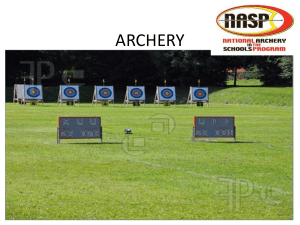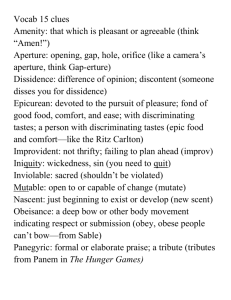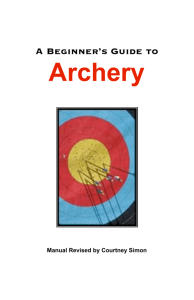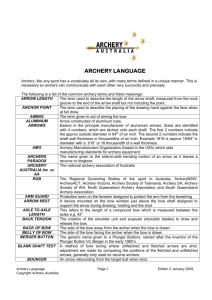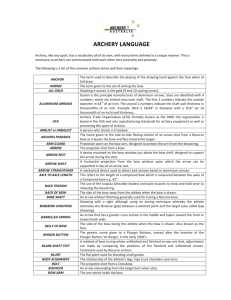Thinking about Bowhunting? - Hunting for Tomorrow Foundation
advertisement
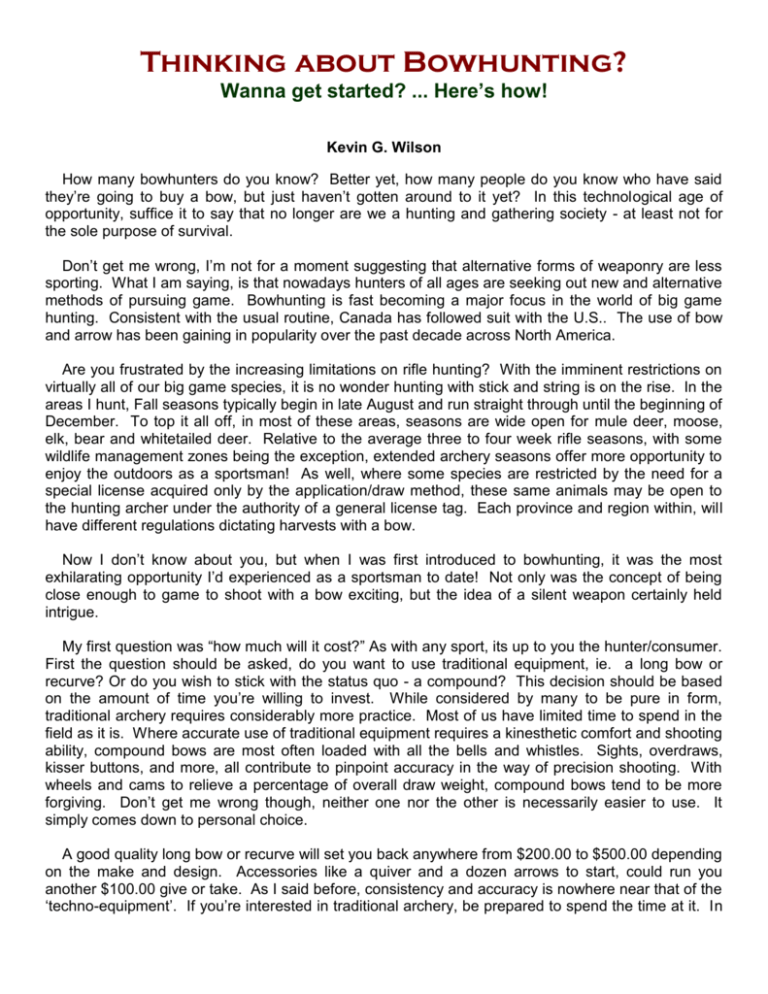
Thinking about Bowhunting? Wanna get started? ... Here’s how! Kevin G. Wilson How many bowhunters do you know? Better yet, how many people do you know who have said they’re going to buy a bow, but just haven’t gotten around to it yet? In this technological age of opportunity, suffice it to say that no longer are we a hunting and gathering society - at least not for the sole purpose of survival. Don’t get me wrong, I’m not for a moment suggesting that alternative forms of weaponry are less sporting. What I am saying, is that nowadays hunters of all ages are seeking out new and alternative methods of pursuing game. Bowhunting is fast becoming a major focus in the world of big game hunting. Consistent with the usual routine, Canada has followed suit with the U.S.. The use of bow and arrow has been gaining in popularity over the past decade across North America. Are you frustrated by the increasing limitations on rifle hunting? With the imminent restrictions on virtually all of our big game species, it is no wonder hunting with stick and string is on the rise. In the areas I hunt, Fall seasons typically begin in late August and run straight through until the beginning of December. To top it all off, in most of these areas, seasons are wide open for mule deer, moose, elk, bear and whitetailed deer. Relative to the average three to four week rifle seasons, with some wildlife management zones being the exception, extended archery seasons offer more opportunity to enjoy the outdoors as a sportsman! As well, where some species are restricted by the need for a special license acquired only by the application/draw method, these same animals may be open to the hunting archer under the authority of a general license tag. Each province and region within, will have different regulations dictating harvests with a bow. Now I don’t know about you, but when I was first introduced to bowhunting, it was the most exhilarating opportunity I’d experienced as a sportsman to date! Not only was the concept of being close enough to game to shoot with a bow exciting, but the idea of a silent weapon certainly held intrigue. My first question was “how much will it cost?” As with any sport, its up to you the hunter/consumer. First the question should be asked, do you want to use traditional equipment, ie. a long bow or recurve? Or do you wish to stick with the status quo - a compound? This decision should be based on the amount of time you’re willing to invest. While considered by many to be pure in form, traditional archery requires considerably more practice. Most of us have limited time to spend in the field as it is. Where accurate use of traditional equipment requires a kinesthetic comfort and shooting ability, compound bows are most often loaded with all the bells and whistles. Sights, overdraws, kisser buttons, and more, all contribute to pinpoint accuracy in the way of precision shooting. With wheels and cams to relieve a percentage of overall draw weight, compound bows tend to be more forgiving. Don’t get me wrong though, neither one nor the other is necessarily easier to use. It simply comes down to personal choice. A good quality long bow or recurve will set you back anywhere from $200.00 to $500.00 depending on the make and design. Accessories like a quiver and a dozen arrows to start, could run you another $100.00 give or take. As I said before, consistency and accuracy is nowhere near that of the ‘techno-equipment’. If you’re interested in traditional archery, be prepared to spend the time at it. In terms of brand names, I personally shoot a Jack Kempf recurve and cedar shaft arrows. There are many different brands out there, and the key lies in how they feel to you the archer. Yes, you can buy second hand equipment, and there are deals out there, but keep in mind ‘buyer beware’. It can be difficult to tell if limbs are cracked, or if the bow has been dry fired (drawn and released without an arrow). In my mind it pays to buy new. For a few extra dollars, you can have peace of mind about your equipment. If a compound bow is more your style, then the prices range a little more substantially. You can get started for anywhere from $250.00 for a bow, quiver, sites, and arrows, on up to $1,000.00 plus. The sky really is the limit. I recommend any of the more common brand names such as High Country, Darton, Jennings, Hoyt, PSE, Martin, and Browning. Important considerations are draw length, poundage, shooting style (ie. fingers or release), sights/no sights, and of course matching your arrow shafts to the bow and draw weight you’re shooting. The most important consideration in determining which bow to buy is draw length. Simply put, ‘if the bow doesn’t fit, its useless’! Draw length refers to the distance between the arrow rest and the knock point at full draw. Typically draw lengths range from 28 inches to 31 inches. Each individual’s draw length will also vary between finger and release shooting. For example, my draw length is 30 inches when I shoot fingers, and 29 inches with a release. Technicians and shop assistants will assist you in determining the correct draw length when purchasing a bow. I often see folks at the archery range who seem a bit ‘over bowed’. What I mean by this, is that they’re drawing too much weight. Bigger is not necessarily better in this game. Yes, arrow speed is increased with increased poundage, but accuracy is generally sacrificed as a result. Its difficult to suggest a good starting point because it is relative to the equipment and the size/strength of the person shooting the bow. On average though, I have found most men begin shooting between 60-65 lbs., and most women range anywhere from 35 on up to 55 lbs. to start. Keep in mind that for the purpose of hunting, a bow must have a draw weight of at least 40 lbs.. Once the bare bow is purchased, now the real fun begins. Accessories can be overwhelming. Take it from me ... start with the basics. Basic pin sights, a side mount quiver, and if necessary, a stabilizer and kisser button are really all that’s needed to get your feet wet. Again, the sky’s the limit when it comes to accessories. Precision aiming aids such as a peep sight, and fluorescent sights as technologically developed as the bows themselves are available. My recommendation is stick to the basics ... the simpler, the better to start with. Once you’ve acquired a feel for your bow, and decided what you feel comfortable with, then try out some alternate accessories. Overdraw systems that mount onto the riser, allow for shorter arrows, and hence increase arrow speed. Hip and back quivers are alternatives to the conventional side mounted ones. In keeping with the idea of starting out basic, I strongly recommend learning to shoot with fingers first. Either a glove or shooting tab will allow you to acquire a true feel for the bow string. Torsion and inconsistant releases can play havoc with arrow flight. Once shooting with fingers becomes second nature, consistancy follows close behind. Many shooters these days are turning to mechanical releases. These are simply mechanical trigger attachments that are strapped around the shooter’s wrist and extend outward to clip onto the bow string. Upon drawing the bow, the trigger is pulled much the same as one would pull the trigger to fire a rifle. These units serve to increase overall accuracy, by eliminating unnecessary torsion. While finger shooting involves the release of two or most often three fingers, mechanical releases only have one point of string contact at which to let go. The biggest downfall of course, is that they are mechanical. Hence, they can break, and if your in the field when it does, you could be out of luck! Take it from me, I’ve even forgotten mine in my vehicle, and consequently was forced to go back to finger shooting. Fortunately, I practice what I preach, and going to fingers was not a serious issue. Beyond these basics of the bow, be sure to purchase the correct size arrow shafts. Arrows are graded based on thickness of their wall and diameter of the shaft itself. Individual bows require different sized shafts, in order to ensure a compatible arrow flex upon release. Your local archery shop technician can assist you in determining which arrows to use. And, as if that’s not enough, there are a variety of arrow types combined with fletching combinations to choose from. The most common are aluminum shafts. Becoming more popular these days, are the carbon arrows, and of course for many traditional shooters, the good ‘ol cedar shafts are still widely preferred. Personal preference dictates whether plastic or feather fletching is used. There are certainly pluses and minuses to using either one. Plastic is more weather proof and less expensive. Feather fletching, while providing a more stable arrow flight, once wet, becomes virtually useless. For more information, or to give archery a try, check out your local archery range or pro shop. In addition to the basic equipment, new bowhunters will quickly realize a definite need for other accessories such as treestands, good camouflage, scents, broadheads, and the list goes on. Inspite of a seemingly overwhelming investment, it really doesn’t take much to get set up. Either way, be prepared to spend the time shooting in the off-season. Remember, practice makes perfect!
